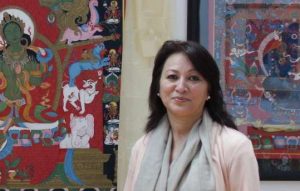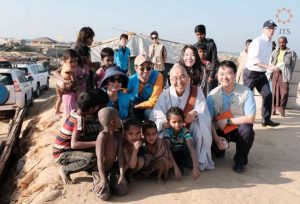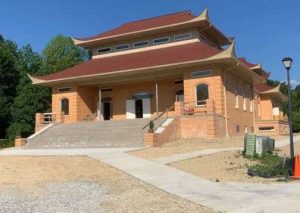After a hiatus of two years, the International Buddhist Film Festival (IBFF) returned for three days from 9–12 December. There were nine premieres from seven countries, and a major highlight was Pawo Choyning Dorji’s popular Lunana—A Yak in the Classroom. Despite restrictions imposed because of the pandemic, IBFF executive director Gaetano Maida has remained busier than ever, with this year’s selection of films being particularly emotional and meaningful. BDG caught up with Gaetano to discuss the cinematic highlights and artistic themes of this year’s festival.
Buddhistdoor Global: Why has Lunana—A Yak in the Classroom been so well-received internationally?
Gaetano Maida: First and foremost, it is a good story, well told. It has the added arthouse elements of a rare look at a beautiful remote location, and a focus on protagonists that are children (with young and compelling actors such as Pem Zam). However, I think the secret sauce is the cinematic connection with Khyentse Norbu, who is none other than Dzongsar Jamyang Khyentse Rinpoche. Lunana’s director, Pawo Choyning Dorji, was the assistant director on Norbu’s Vara and also the producer of his Hema Hema—Sing Me A Song While I Wait, with which Lunana also shares the cinematographer, Jigme Tenzing.
Along with the wonderful Honeygiver Among the Dogs, by Dechen Roder (which Jigme Tenzing also lensed), a nascent Bhutan-focused cinema community is developing and gaining well-deserved international attention.
BDG: You are also showcasing a Zen-themed documentary called Descending the Mountain. The film’s theme hearkens back to the early days of encounters between Buddhist teachers and the psychedelic movement. What would you say about its perspective and conclusion about the relationship between scientists and Buddhists?
GM: I think it is an ongoing and evolving relationship, and who knows: it might have had historical roots in India! Many earlier adherents in the West got to Buddhist practice after being startled and inspired by their experiences or experiments with entheogens and psychedelics. Back then, there was very little science to help assess the nature and variety of mental states being stimulated by the drugs, or by meditation, for that matter.
Things have changed over the years, especially lately with the tentative decriminalization of legitimate scientific studies with various psychotropic substances. These can now be compared with many studies via FMRI scans by advanced meditators such as Mingyur Rinpoche and Matthieu Ricard.
As we see in the film, Buddhists are exploring the mind from within, and scientists are exploring the mind from without. It is not yet clear whether they are referring to the same “thing” or dimension. The film suggests that there is much to be learned through these efforts by all concerned, but the work is far from conclusive. The film takes a very entertaining approach to exploring all these issues.
BDG: Let us discuss the market for Buddhist-themed films. There are documentaries and fiction, but apart from this distinction, is there a preference for more anthropological movies, such as stories of Buddhists in remote regions, or of philosophical themes such as rebirth and karma? In other words, what themes do better and why?
GM: This is a critical question that touches on the viability of the cinema experience that we champion at Buddhist Film Foundation. Audiences absolutely embrace both well-made documentaries and dramatic works, regardless of the thematic range or style. That said, we do tend not to include films that are only hagiographic stories about teachers, be they living or dead; those usually target the communities in those traditions rather than the general audiences we have been cultivating.
However, we have found that audiences are highly divided. There is no “Buddhist” audience per se. There tend to be audiences for Chinese Buddhist stories, and for Tibetan Buddhist stories, and Japanese Buddhist stories, “Western” Buddhist stories, and so on, but it is very rare that these audiences cross over.
In a sense, this is a key part of our mission: to pitch a big tent and include all participants, both from the content side and the audience side. We have presented more than 300 films from nearly two dozen countries, and it is our hope that demonstrating through cinema the diversity of Buddhist traditions and cultures, we can help dissolve some of the silos among them. I have to say that nowhere else can so many traditions be seen in one place at one time, as there is no one “Buddhism” but many “Buddhisms,” there is no audience strictly definable as “Buddhist.”
BDG: Who are some of the formative figures that contributed to the rich Buddhist heritage of the Bay Area, and what is the community like today?
GM: The San Francisco Bay Area has historically been associated with all the American Buddhist “firsts.” These include the first temples, which were built by Chinese immigrants in San Francisco in the 1850s; the first Buddhist publication in English, which was a journal called The Buddhist Ray running from 1887–94 and based in Santa Cruz; the first resident Buddhist priests (who came from Japan and settled in San Francisco in 1899); the first Zen monastery, which was built in 1966 in Tassajara; and we cannot underestimate the deep resonance here of Gary Snyder, Allen Ginsberg, Jack Kerouac, and Alan Watts from the 50s and 60s.
In addition, several major Buddhist institutions have established themselves here: Spirit Rock, Nyingma Institute and Dharma College, San Francisco Zen Center, Green Gulch Farm Zen Center and Tassajara Zen Mountain Center, City of Ten Thousand Buddhas and Berkeley Buddhist Monastery, Plum Village’s Parallax Press, Buddhist Church of America, and so on.
Finally, let us not forget there’s a very large and diverse Asian population in the area, many of whom are from Buddhist cultures and are continuing to support all their institutional and community elements here—Burmese, Cambodian, Chinese, Japanese, Korean, Taiwanese, Thai, Tibetan, Vietnamese, and more. Furthermore, both UC Berkeley and Stanford have highly regarded Buddhist studies programs with endowed professorships.
BDG: Talk a little about your other event, the Burma Spring Benefit Film Festival. What kind of movies are being showcased at this festival?
GM: The Burma Spring Benefit Film Festival (BSBFF) was an instinctive response to the violent military coup and suppression of dissent that began in February. IBFF had presented a selection of films by graduates of the Yangon Film School a few years ago, and a few of us in the San Francisco Bay Area who all had connections of some sort with Myanmar (Alan Senauke, Kenneth Wong, Ellen Bruno, Jeanne Hallacy, and me) got together to ask: “What can we do, what is needed?”
We concluded that with the banks and many enterprises closed, money was in desperately short supply among those in danger for doing humanitarian aid or human rights work, so we decided to do what we do best, and organized a film festival to raise awareness and donations.
All the films (we had 41 in June) were offered to us for free, and the team curated a program of works about or made in Myanmar, with a special effort to showcase filmmakers from there (so long as their participation didn’t put them or their families at risk). There were many documentaries of course, a few dramatic works, some animation, and a few performance films. We also had 10 live-streamed panel discussions with a great roster of speakers; the recorded videos of those are posted on the festival website and on the BSBFF YouTube channel. We raised nearly US$50,000 in two weeks.
Fast-forward to the present, and the news from Myanmar continues to be alarming and devastating (Aung San Suu Kyi was this month sentenced to four years in prison in a judicial process widely condemned as illegal and unfair), with deaths, imprisonment, exile, and attacks on ethnic states reported regularly. We decided to present an Encore Edition starting on next year’s anniversary of the coup, 1 February, and running for two weeks, with the same goals: to raise international awareness and donations. There is no price set for an all-Access pass; any donation is eligible and no one will be turned away for lack of money. We are curating now and hoping to find a few good new films to add to the program. There will be one or two recorded panels.
BDG: Thank you very much for your time as always, Gaetano.
GM: It has been a pleasure, and I hope more audiences enjoy the films we have curated.
See more
Buddhist Film Foundation
Beskop Bhutan
Descending the Mountain
Burma Spring Benefit Festival
Related features from Buddhistdoor Global
Film Review: Khyentse Norbu’s Looking for a Lady with Fangs and a Moustache
Sing Me A Song: The Impact of Screens on a Remote Bhutanese Mountain Village
Buddhist-Influenced Filmmaking in an Extraordinary Time: An Interview with Gaetano Maida













